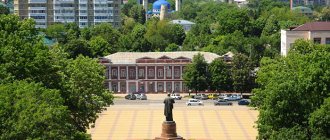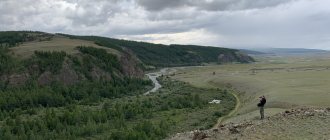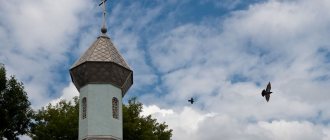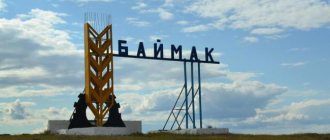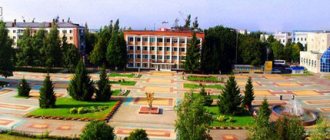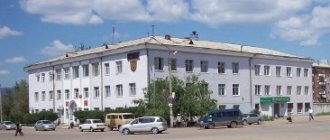Little America: the city of Kanash, Chuvash Republic
Hello, Russians!
All of you are well aware of the republics of the North Caucasus (I know, the most respected people live there), and you are much less familiar with the rest of the small nationalities of the country. Below we will talk about the most stable city of the Chuvash Republic with a proud name - Kanash.
The distance from Moscow is 666 km, a large railway junction of local importance, of course with Lenin in the city center, you can’t fault it. About 52 thousand population, mostly, naturally, Chuvash, about 65%, the rest are Russians and Tatars (150 km to Kazan). According to statistics from the LEVADA Center, the people with the highest IQ on the planet. On the planet Mars, of course. Well, that is if you don't count NASA's Mars rovers, and there are only two of them, so we are truly the smartest. It is worth saying that the Chuvash are Orthodox, although, according to some information, during the time of the Mongols they were pagans. But Rus Ivan came, and we joyfully bowed to him, like evolution to Valuev, and became Orthodox for the amusement of the Tsar. Integration has begun, and now, as in all Russified republics, native speech, all sorts of piruns and other gods can only be found in villages.
Kanash
For some reason, after this word I want to spit, although this was not always the case. When there was a cheerful movement in the country in the 90s, my dad was drinking at the factory, and, lighting a cigarette in the school toilet at the age of 13, like him, I was happy. Going to dances on Saturdays in the park with the aim of getting pissed off or, conversely, attacking another area, gangs of boys, attention to the words of successful imprisoned authorities. Development proceeded like many others, and in 2005 it even became the best small town in Russia. But this is a story, and she is a two-ass whore. I move on to the current Kanash, fashionable and glamorous.
Work and money
The average salary is 10-15 tr, and 18-20 is already a success, you can proudly voice the amount and see envy and reverence in the eyes of your interlocutor. The city-forming plant VRZ (bathroom repair plant) belongs to the concern “TRACTOR FACTORIES OF RUSSIA” and regularly, year after year, sucks money from the budget, that is, tractor factories take out another loan from the state, the loot goes down the chain, in the end the workers get 10 thousand each, but since the plant is worth it, it’s considered cool: “But I don’t do shit, damn it, I get 10, azazazaz, how fucking awesome I am.”
But there is a very interesting point! Remember when I said that we have the highest IQ? This, and the fact that Moscowabad is only 666 km away (this is true, by the way, the sign was there even earlier), did their job, and half of the city works in the capital on shifts (This is how half of Russia works, but I don’t know for half of Russia, and the fact that half of Kanash is the holy truth), and receives it royally. And since all this successful crowd spends money in their homeland, there are a lot of places to lose money - cafes, restaurants, shops, nightclubs (There is only one left, but my favorite clubber, the local DJ has a favorite track FOR YOU, I WILL GAVE YOU, last summer it was spinning there non-stop), etc. There are also plenty of “FAST MONEY” type offices, and libraries on every corner, but no one has ever seen them.
That part of the people who do not work in Moscow and do not have the means to somehow survive and pay for the Lada VAZ loan broken by their drunken son last year, work in gardens and vegetable gardens, travel to villages to grow potatoes there (I As a child, I thought that people all over the planet do this, because, damn it, instead of the alphabet, they taught us to plant and hill and dig potatoes) and somehow last a month.
Service and goods in Kanash are up to par. At the very fucking lowest level, huh. But here, many waiters don’t even think about getting a tip, because for them the standard of social behavior is a fat saleswoman from a rural district. Not everywhere, but! If suddenly (God forbid) you find yourself with us, go to “OUR BAR”, a cafe not far from the center, the best cafe, where there is normal booze, and everything on the menu will really be served to you (Usually Kanash cafes have Baltic 7 and “this salad is just left”). Let me note that a nice plus is that Magnit, Pyaterochka and other crap are actively coming to us, and our Chuvash store owners decided to create a brand to resist retailers and are coping with this by lowering prices (Really, where have you seen prices lower than in "magnet"?) and improving the quality of goods and service. On such stores hang a Chuvash swastika in the form of patterns and the slogan “OURS: BUY CHUVASH.” It doesn’t rhyme, but it’s high quality and inexpensive; I go there with pleasure when I’m home.
Pubs, bars, cafes, booze
About the cafe it was said above, I have nothing to add, eat either in OUR BAR or don’t give a fuck about your sanctions and don’t eat at all. But to get drunk - guys, aren’t we Russians? I took a funfir in the evening behind the garages, went to the club, there was also a couple of vodka and colas to disperse, and success! You are the king of the dance floor, all the chicks are yours. No, a little back. So, about booze, who doesn’t know, Chuvashia has good beer. I won’t compare it with Czech or German, this is a different weight category, but the beer is one of those that you wouldn’t be ashamed to bring to Moscow, say, to your work colleagues. In short, the inscription on the label BOUQUET OF CHUVASHIA is like Egypt. It doesn’t seem like the Maldives, but it’s no longer Sochi. Try it.
Social sphere
The inhabitants of the city (Active youth, first of all) are ordinary Russians, but, surprisingly, we also have guests from the mountains, who mainly trade gifts of nature at the market. No ethnic conflicts, maybe this is because, as Johann Goethe said, “No blacks, no racism”? I don't know, ask yourself. The hospital in the city is crap, I had to visit the traumatologist often, his hands have been shaking since Afghanistan, he performed such an operation on me that it took me 2 years to heal the consequences. Education is crap, but it depends on your luck: if dad is a pussy in childhood, then his son will grow up well and go to a car repair plant, if not, to a vocational school and then go to Moscow to earn money. There are only two universities, they are for those who work and, well, the office requires a tower, but the person does not have one. No problem, you go there, pay money (pennies compared to Moscow), and after 3 years you have a Higher Education. It’s not like in shitty America, you pay a lot of money, but you also have to study.
Transport and roads
Minibus fare is 18 rubles. For comparison, in the center of Russian Orthodoxy Tver with a population of ~400k, I drove for 15. I suspect this has something to do with the constant flow of money from the capital. Auto. Mostly, of course, ours, with a few stray foreign cars. There are Chuvash horsemen at low priors, but not many. But the idiots who bought the grant on credit and are paying 100 rubles for a taxi to pay for it even if they eat their ass. from end to end. The roads are like in Russia, what can I add here... But spirituality! There was one church five years ago, now there are two, and another temple is being built. For what? You yourself know - to raise Russia. In general, I go regularly myself, I recommend it, Father Kondrat is a golden man. When sober. Doesn't matter.
It would be worth adding something else here, useful information, or ANALYTICS. But you know, I think that there is such a Kanash in the heart of every national project worker, we are all Russian people, and tomorrow we will go to the factory. Someone has to fucking raise Russia.
We thank the friendly “National Project” - the center of pride for our country - for the amazing report.
Until the New Year 2022 remains
Kanash is a city with its own history, which is the administrative center of the Kanash region. An industrial city, the transport center of Chuvashia, a major railway center of the republic. A little history of the city:
Retreat. (does not apply to Kanash, but many people confuse it)
In 1588, a Chuvash of the Muslim faith, Atishch, moved to these lands from the Karin Principality (the region of the Cheptsa River basin adjacent to today's city of Slobodsky, Kirov Region), founded the village of Atishchevo and there were then 3 households there. And after 100 years, the number of households increased to 132.
In 1602-1603, the Muslim preacher Sheikh Rana was sent from the Ar side. The settlement that formed near the home of Sheikh Rana initially bore the name Sheikhrany, then it was simplified to Shikhrana. The village was separated by a ravine.
At the beginning of the 19th century, the villages grew together and began to be called Atishchevo-Shikhrany, and in common parlance simply Shikhrany (now it is Sugaikasy)
Where did Kanash begin?
In 1891, by decree of Emperor Alexander III, construction of a railway from Ryazan to Kazan began. In 1891 they began clearing forests for the railway near Shikran (Sugaikasov)
In 1892, a railway station was built. A station village was formed around the station. The village and the station were named after the nearest village - Shikhrany (do not confuse it - the Shikhrany station and the village of Shikhrany are different administrative points).
Since 1905, after the construction of the church, Shikhrany became a village.
On August 20, 1920, the station and the village of Shikhrany were renamed Kanash (translated from Chuvash as Council).
In 1925, Kanash received city status.
I have always wondered why some cities measure their age from the first mention in chronicles, and some from the date they received city status?
They began to lay the railway, cutting down forests, in an empty uninhabited area in 1891.
The station and the village of Shikhrany appeared in 1892. This means Kanash turned 124 years old in 2021 (and officially only 91 years old). Water towers
The first water tower for refueling steam locomotives with water was built in 1892, when construction of the railway began.
This is what the Western water tower looks like today. There is no top, it was made of wood, fell into disrepair over time and was demolished. The tower is an architectural monument of the city (Zheleznodorozhnaya St.) This is the second water tower. It was built in 1925
This is what the Vostochnaya water tower looks like today (Zheleznodorozhnaya St.)
Locomotive depot
The locomotive depot at Shikhrany station was built in 1893 (the building has not survived; a railway station now stands on this site)
In 1931-1932 A new locomotive depot is being built at Kanash-II station. Later it became a locomotive.
Since 2009, the locomotive depot was closed and a replacement TCHE Yudino station and the Kanash multiple unit depot were created on its basis.
Kanashsky Car Repair Plant
The Car Repair Plant (VRZ) was the city's main enterprise. It employed about 5 thousand people when the city's population numbered about 45 thousand people.
Laying the foundation (photo from 1934). Construction began on March 26, 1934 in an empty open field, 5 kilometers from the railway station.
Beginning of construction of a car repair plant (photo from 1934). People from all over the area went to the construction site.
Carriage plant (photo from 1935). A year and a half after the start of construction, on August 25, 1935, the first eight cars left the repair. On June 16, 1936, the People's Commissariat of Railways of the USSR issued an order to complete the construction of the Kanash Car Repair Plant. This day is considered the birthday class=”aligncenter” width=”699″ height=”438″[/img] During the war, 4 armored trains left the plant: “Komsomol of Chuvashia”, “For the Motherland”, “Name of M.I. Kutuzov” ", "In the name of A.V. Suvorov"
One of the first workshops of the plant is a thermal power plant. Until recently, it provided heat to part of the city. When people approached the city, these two pipes were visible from afar, like beacons.
Then the plant switched from fuel oil to gas and one pipe was shortened. And they became like Plug and Tarapunka.
Water tower VRZ. Architectural monument. It was blown up on March 12, 2007, because the new owners of the plant wanted to build a modern workshop in this very place. Even though specialists did the explosions, it didn’t work the first time, so they had to carry out 2 more explosions.
The tower was strong, it would have stood for another 300 years as an architectural monument,
But how long the new workshop will last is a question. It is, of course, beautiful and very large, but it stands in a swamp.
You can still see cars like this with the inscription “Kanash-VRZ” on the roads of the country.
Once upon a time the plant thundered, constantly receiving the Red Banner. In 1981, the plant was awarded the Order of the Red Banner of Labor. People were proud of the title of railway worker. Today, not a trace remains of its former glory. Today the plant is being sold and resold, the plant no longer belongs to the railway and is called “Promtractor-Wagon” (Ilyich St., 1a).
Kanashsky Automotive Components Plant
The plant was founded in 1944 as an engine repair plant, since 1948 - a repair plant, since 1959 - an auto parts plant (AZCh), since 1976 - an automobile components plant (KAAZ) (Frunze St., 6).
KAAZ plant management. It was this plant that gave rise to the construction of the Western residential microdistrict.
Not all workshops of the plant are working today.
Some of the workshops were sold, and small private enterprises were organized on their basis. Kanashsky cutters plant
In 1927, the Dub timber harvesting artel was created in Kanash. In 1937 it was renamed the artel named after. Stalin. Since 1960, it has been a bed manufacturing factory,
and since 1963 - a cutter factory.
Cutters plant (Zheleznodorozhnaya str., 211). The plant is located on the outskirts of the city, surrounded by the private sector.
Kanashsky technological equipment plant
In 1935, the Gorpromkombinat was opened in the city, which produced wax, matches, etc.
After the war, iron casting and welding production was organized here, therefore, from April 6, 1955, it was a foundry and welding plant, since 1963, a foundry-mechanical plant, since 1966, a boiler-welding plant, and since 1968, a Kanash technological equipment plant. (KZTO).
On October 21, 2001, the enterprise became part of OJSC Cheboksary Research and Production Instrument-Making Enterprise Elara. On November 15, 2007, the plant became the property of the Moscow industrial and investment company Splitstone (36 Svobody St.)
Kanash Electric Forklift Plant
The electric forklift plant was organized on the basis of a tractor repair station in 1961.
In the fall of 1964, the first electric forklift, model EP-201, was assembled. Now on the territory of the plant there is also a machine-building plant for crushing and screening equipment (“Kanmash - DSO”). Kanmash DSO products include crushing, grinding, processing, grinding equipment and complexes. Kanash plant of ceramic wall materials
Construction of the plant began in 1984 and was put into operation in 1989. Due to the beginning of “perestroika,” the plant changed owners several times, but each time it was declared bankrupt. The rebirth of the ceramic wall materials plant, already under the Keramika LLC brand, began in September 2011. (Ulyanovskoe highway, 2)
Kanashsky
The Kanash Automobile Repair Plant began operating in May 1961 on the basis of the engine repair shop of the auto parts plant. Since 1972, it has been an Experimental Automotive Repair Plant, and since 1988, the plant first repaired trucks, and then began producing trailers and semi-trailers (Krasnoarmeyskaya St., 79). On February 26, 2003, on the basis of the plant, the Limited Liability Company “AvtoSpetsTekhnika-Kanash”, LLC “AST-Kanash”, a plant for the production of trailed equipment (Krasnoarmeyskaya St., 80) was formed.
Kanashsky
The plant was founded in 1965. It produced floor tiles, foil insulation, and linoleum.
Today the plant is closed, partially sold, partially destroyed, almost all the glass is broken.
And in the building of the former factory administration today there is a hotel "Spectrum" (Ilyich St., 1)
Kanashsky
In 1935, the Avangard diversified artel was created in the city. In 1946, the artel was transformed into the Druzhba promartel, which began producing bricks, ropes, and products for horse-drawn transport. In 1954, the Druzhba promartel produced the first drying oil and paint. The plant was put up for sale. (According to some reports, the plant now has a new owner).
Kanashsky Bakery No. 1
The bakery moved to this building in October 1961. (Moskovskaya st., 1)
Now here is the bakery and confectionery shop of the Akkond factory, which produces the most delicious chocolate.
Kanashsky Bakery No. 2
The plant has been operating since 2002 (Mashinostroiteley str., 6-a)
Kanashsky cheese-making plant
In 1953, a creamery appeared in Kanash. In 1985, the company moved to a new building and changed its name to the Kanash cheese-making plant (elevator district)
Kanashsky meat processing plant
In 1930, a slaughterhouse opened in the city. In 1937 - a sausage shop. In 1938, a meat processing plant was opened at their base.
Today the plant is not operating, it is put up for sale (Kanashskaya St., 71).
Kanash confectionery factory
In 1935, a gingerbread workshop (or factory) was opened in Kanash (the building has not survived). In 1940, the factory became a confectionery (Cheboksarskaya St., 27). They mainly produced fruit caramels.
The factory moved to the territory of a former butter factory (30 Let Chuvashii St., 1), and this place was empty for many years. All that remains of the former confectionery factory is a destroyed brick wall. Today, a 9-story residential building stands on this site.
Kanash city power grids
The building of the first Kanasha power station. On November 7, 1929, the city's first power plant was launched. On its basis, City Electric Networks were created in 1969 (20 Svobody St.).
Southern power grids Chuvashenergo
Until 1961, the only source of electricity supply in Kanash and the region was the thermal power plant of the Kanash Car Repair Plant.
There was not enough electricity, so in June 1968 it was decided to create the Southern Electric Networks on the basis of the Kanash electrical grid region of the Chuvash electrical networks.
Kanash Furniture Factory
In 1930, a furniture manufacturing artel “May 1” was created in the city. Then a furniture factory was created on its basis.
Furniture factory (26 Svobody St.).
The factory closed. Now this building houses the Mega Center shopping complex.
A new (private) furniture factory was created on the basis of a training and production enterprise (TPE) of the society of the blind.
Kanash clothing factory "Rassvet"
On April 16, 1955, the sewing workshop became a garment factory.
Today it is the KAYSAROW clothing factory. The traditions remain, the factory continues to sew school uniforms, but unlike the old ones, they are very elegant (Pushkina St., 8).
Kanash fulling factory
The factory, founded in 1958, was located on the territory of a timber trading base. It was closed in the early 90s. In 1992, the fulling factory “Sever” was formed on the basis of the consumer services plant. In addition to ordinary felt boots, they produce decorated felt boots, slippers and booties, hats and bath mats (7 Bolnichny Lane).
Kanashsky Beverage Enterprise
The beverage company was founded in 1935. At first it was a kvass workshop, where, in addition to kvass, they produced soda and fruit drinks. In 1991, the beverage enterprise was renamed the Poisk production plant (24 Svobody St.).
Kanash gas filling station
Now many cars are converted to gas. This is the gas station where they refuel.
Kanash oil depot
Oil depot in Kanash (Zheleznodorozhnaya str., 273). Oil tanks
Construction organizations in Kanash
"Uchdorstroy" is the first construction organization that built residential buildings in Kanash. It built 2-story houses on the street. Pushkin
Construction and installation train 541 (SMP-541)
The construction and installation office (CMA) of the Kaztransstroy trust was created on February 29, 1952 for the construction of railway facilities. They are responsible for a car repair plant, a railway station, a Palace of Culture, a city administration building, schools and residential buildings. Then SMK was renamed SU-102, then SMP-541 (construction and installation train). Now the organization has been liquidated, but the residential area between VRZ and Sotsgorod is still called SMKa.
Rural Construction Plant (SSK)
The company was located in the area of the elevator and produced reinforced concrete structures for rural construction. In 2007, SSK was closed. Grass is already sprouting on the asphalt in front of the administrative building.
The workshop windows are covered with plywood and the building is in good condition.
